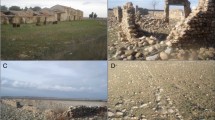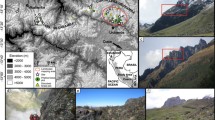Abstract
The legacy of ancient human practices can affect the diversity and structure of modern ecosystems. Here, we examined how prehistoric refuse dumps (“middens”) impacted soil chemistry and plant community composition in forests along the Chesapeake Bay by collecting vegetational and soil nutrient data. The centuries- to millennia-old shell middens had elevated soil nutrients compared to adjacent sites, greater vegetative cover, especially of herb and grass species, and higher species richness. Not only are middens important archaeological resources, they also offer a remarkable opportunity to test ecological hypotheses about nutrient addition over very long time scales. We found no evidence, for example, that elevated nutrients enhanced invasion by non-native species as predicted by the fluctuating resource hypothesis. However, we did find that elevated nutrients shifted community structure from woody species to herbaceous species, as predicted by the structural carbon-nutrient hypothesis. These results highlight the long-lasting effects that humans can have on abiotic and biotic properties of the natural environment, and suggest the potential for modern patterns of species’ distributions and abundances to reflect ancient human activities.



Similar content being viewed by others
References
Bellemare J, Motzkin G, Foster DR (2002) Legacies of the agricultural past in the forested present: an assessment of the historical land-use effects on rich mesic forests. J Biogeogr 29:1401–1420
Blume HP, Leinweber P (2004) Plaggen soils: landscape history, properties, and classification. J Plant Nutr Soil Sci 167:319–327
Brennan LA (1974) The lower Hudson: a decade of shell middens. Archaeol East North Am 2:81–93
Bronk Ramsey C (2009) Bayesian analysis of radiocarbon dates. Radiocarbon 51:337–360
Bronk Ramsey C (2013) OxCal 4.2. http://c14.arch.ox.ac.uk/. Accessed 6 Nov 2013
Brown CA (1936) The vegetation of the Indian mounds, middens, and marshes of the Plaquemines and St. Bernard Parishes. La Dep Conserv Bull 8:423–440
Burton JI, Mladenoff DJ, Clayton MK, Forrester JA (2011) The roles of environmental filtering and colonization in the fine-scale spatial patterning of ground-layer plant communities in north temperate deciduous forests. J Ecol 99:764–776
Cox CJ (2007) Survey and limited assessment of archaeological resources in the Rhode River region, Anne Arundel County, Maryland. Maryland Historical Trust, Crownsville
Curtiss AH (1879) A visit to the shell-islands of Florida. Bot Gaz 4:154–158
Davis M, Grime J, Thompson K (2000) Fluctuating resources in plant communities: a general theory of invasibility. J Ecol 88:528–534
Dupouey JL, Dambrine E, Laffite JD, Moares C (2002) Irreversible impact of past land use on forest soils and biodiversity. Ecology 83:2978–2984
Erlandson JM (2014) Shell middens and other anthropogenic soils as global stratigraphic signatures of the Anthropocene. Anthropocene. doi:10.1016/j.ancene.2013.12.001
Fridley JD, Wright JP (2012) Drivers of secondary succession rates across temperate latitudes of the Eastern USA: climate, soils, and species pools. Oecologia 168:1069–1077
Gallivan M (2011) The archaeology of native societies in the Chesapeake: new investigations and interpretations. J Archaeol Res 19:281–325
Gibb JG, Hines AH (1997) Selby Bay subsistence strategies at the Smithsonian pier site, Anne Arundel County, Maryland. Maryland Archaeol 33:59–76
Gilliam FS (2007) The ecological significance of the herbaceous layer in temperate forest ecosystems. Bioscience 57:845–858
Graves JH, Peet RK, White PS (2006) The influence of carbon-nutrient balance on herb and woody plant abundance in temperate forest understories. J Veg Sci 17:217–226
Grime JP (2001) Plant strategies, vegetation processes, and ecosystem properties. Wiley, New York
Karalius T, Alpert P (2010) High abundance of introduced plants on ancient Native American middens. Biol Invasions 12:1125–1132
Kelly L (2006) The vascular flora of Huggins Island, Onslow County, North Carolina. Castanea 71:295–311
Lima da Costa M, Kern DC (1999) Geochemical signatures of tropical soils with archaeological black earth in the Amazon, Brazil. J Geochem Explor 66:369–385
Marks PL, Wesley FR, Gardescu S (2008) The vascular plant diversity of the Finger Lakes region of central New York State: changes in the 1800s and 1900s. J Torrey Bot Soc 135:53–69
McAvoy WA, Harrison JW (2012) Plant community classification and the flora of Native American shell-middens on the Delmarva Peninsula. Maryland Nat 52:1–34
McLaughlin SB, Wimmer R (1999) Calcium physiology and terrestrial ecosystem processes. New Phytol 142:373–417
McMichael CH, Piperno DR, Bush MB, Silman MR, Zimmerman AR, Raczka MF, Lobato LC (2012) Sparse pre-Columbian human habitation in western Amazonia. Science 336:1429–1431
Miller HM (2001) Living along the “Great Shellfish Bay”: the relationship between prehistoric peoples and the Chesapeake. In: Curtin PD, Brush GS, Fisher GW (eds) Discovering the Chesapeake: the history of an ecosystem. Johns Hopkins UP, Baltimore, pp 109–126
Mosher ES, Silander JA, Latimer AM (2009) The role of land-use history in major invasions by woody plant species in the northeastern North American landscape. Biol Invasions 11:2317–2328
Norman E (1976) An analysis of the vegetation at Turtle Mound. Biol Conserv 39:19–31
Parker JD, Richie LJ, Lind EM, Maloney KO (2010) Land use history alters the relationship between native and exotic plants: the rich don’t always get richer. Biol Invasions 12:1557–1571
Pimm S, Russell G, Gittleman J, Brooks T (1995) The future of biodiversity. Science 269:347–350
Plue J, Hermy M, Verheyen K, Thuillier P, Saguez R, Decocq G (2008) Persistent changes in forest vegetation and seed bank 1,600 years after human occupation. Landscape Ecol 23:673–688
Resende Correa G, Schafer CEGR, de Freitas Melo V, de Souza KW, Ker JC, Mariano Rorigues IM, Senra EO (2011) Physical and chemical attributes of archaeological soils developed from shell middens in the Regiao dos Lagos, Rio de Janeiro, Brazil. Revista Brasileira de Ciencia do Solo 35:1100–1111
Rick TC, Henkes GA, Lowery DL, Colman SM, Culleton BJ (2012) Marine radiocarbon reservoir corrections (Δ R) for Chesapeake Bay and the Middle Atlantic Coast of North America. Quatern Res 77:205–210
Rick TC, Reeder LA, Cox CJ, Sperling ST, Jansen A, Hines AH (2014) Shell middens, cultural chronologies, and coastal settlement on the Rhode River sub-estuary of the Chesapeake Bay, Maryland. Geoarchaeology (in press)
Ross NJ (2011) Modern tree species composition reflects ancient Maya “forest gardens” in northwest Belize. Ecol Appl 21:75–84
Sax D, Gaines S, Brown J (2002) Species invasions exceed extinctions on islands worldwide: a comparative study of plants and birds. Am Nat 160:766–783
Schmidt MJ (2014) Dark earths and the human built landscape of Amazonia: a widespread pattern of anthrosol formation. J Archaeol Sci 42:152–165
Silvertown J, Poulton P, Johnston E, Edwards G, Heard M, Biss PM (2006) The Park Grass Experiment 1856–2006: its contribution to ecology. J Ecol 94:801–814
Stalter R, Kincaid D (2004) The vascular flora of five Florida shell middens. J Torrey Bot Soc 131:93–103
Stalter R, Leyva M, Kincaid DT (1999) The flora of Indian shell rings from coastal South Carolina to northern Florida. Sida 18:861–875
Thompson VD, Turck JA, DePratter CB (2013) Cumulative actions and the historical ecology of islands along the Georgia Coast. In: Thompson VD, Waggoner JC Jr (eds) The archaeology and historical ecology of small scale economies. University Press of Florida, Gainesville, pp 79–95
Tilman D, Dodd ME, Silvertown J, Poulton PR, Johnston AE, Crawley MJ (1994) The Park Grass Experiment: insights from the most long-term ecological study. In: Leigh RA, Johnston AE (eds) Long-term experiments in agricultural and ecological sciences. CAB International, Wallingford, pp 287–303
Vanderplank SE, Mata S, Ezcurra E (2014) Biodiversity and archeological conservation connected: aragonite shell middens increase plant diversity. Bioscience 64:202–209
Vellend M, Baeten L, Myers-Smith IH, Elmendorf SC, Beauséjour R, Brown CD, De Frenne P, Verheyen K, Wipf S (2013) Global meta-analysis reveals no net change in local-scale plant biodiversity over time. Proc Natl Acad Sci 110:19456–19459
Vitousek PM (1997) Human domination of Earth’s ecosystems. Science 277:494–499
Von Holle B, Motzkin G (2007) Historical land use and environmental determinants of nonnative plant distribution in coastal southern New England. Biol Conserv 136:33–43
Warton DI, Hui FKC (2011) The arcsine is asinine: the analysis of proportions in ecology. Ecology 92:3–10
Wright HT (1973) An archaeological sequence in the middle Chesapeake Region, Maryland. Maryland Geological Survey Archaeological Studies
Acknowledgments
The Smithsonian Institution/SERC supported this work with an internship to D. Weller and a fellowship to S. C. Cook-Patton. Funds from the National Museum of Natural History Small Grant (Rick) and the National Geographic Society (Rick) supported radiocarbon dating. We also thank Tuck Hines, Robert Aguilar, Allison Everett, Midge Kramer and researchers in the SERC Crab Lab who provided logistical support and advice.
Author information
Authors and Affiliations
Corresponding author
Electronic supplementary material
Below is the link to the electronic supplementary material.
Rights and permissions
About this article
Cite this article
Cook-Patton, S.C., Weller, D., Rick, T.C. et al. Ancient experiments: forest biodiversity and soil nutrients enhanced by Native American middens. Landscape Ecol 29, 979–987 (2014). https://doi.org/10.1007/s10980-014-0033-z
Received:
Accepted:
Published:
Issue Date:
DOI: https://doi.org/10.1007/s10980-014-0033-z




